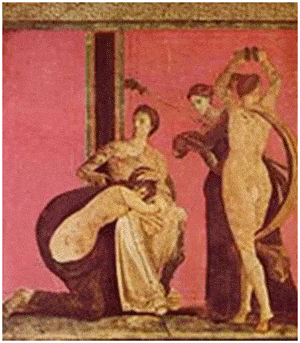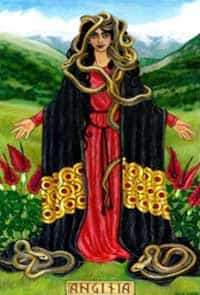
By Judy Pinegar
Meanwhile, the Romans who always had to re-name the Greek gods and goddesses to fit their “new” civilization seem to have adapted Angitia into Bona Dea, an ancient and holy Roman goddess of women and healing. Women also referred to her as Fauna, but men were not allowed to use that name, or attend her secret ceremonies and festivals. Bona Dea, “the Good Goddess” protects women through their changes, and is believed to watch over virgins and matrons especially. She was skilled in healing and herb lore, and snakes and wine were sacred to her. As a healing goddess, the sick were tended in her temple garden with medicinal herbs. Bona Dea was portrayed sitting on a throne, holding a cornucopia. The snake is her attribute, a symbol of healing, and consecrated snakes were kept in her temple at Rome, tended by her priestesses.
Under the laws of the Roman republic, patrician women were not supposed to drink wine, and could be punished, if caught. But by calling it “milk” the ancient and sacred practices could be reconciled with the rules of Roman Society. Bona Dea’s secret festival for women was held at night during the First of May, in the house of the chief elected official ( although he was not allowed to attend), the Vestal Virgins officiated, and a great jar of wine was in the room, although it was called “milk” and the jar was called a “mellarium” or honey jar. After making libations to the Goddess Bona Dea, the women drank and danced to music. It is said that later in the history of the empire this festival “degenerated” into wild and extravagant affairs, such as the Greeks had with Dionysus, the God of Wine.
Judy Pinegar is a writer. Part of this three part series appeared in the Corriere della Valle Magazine
Thinking of buying or selling?
For all your real estate needs
Email or call:
John J. O’Dell Realtor® GRI
(530) 263-1091
Email jodell@nevadacounty.com

